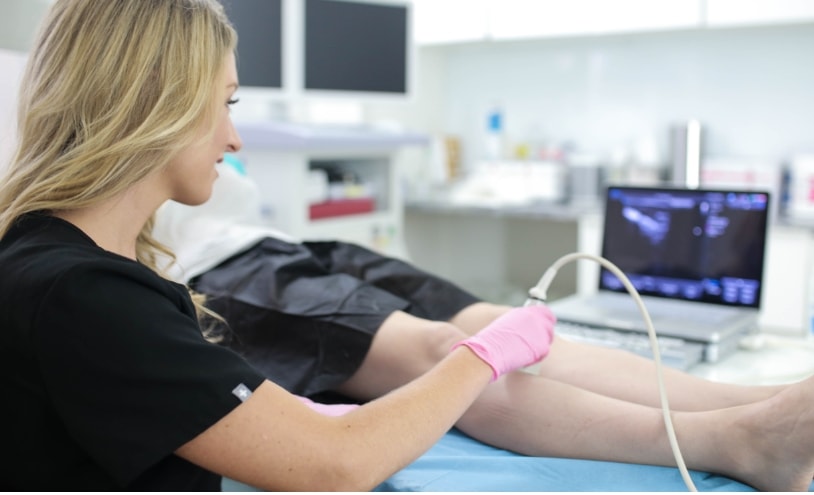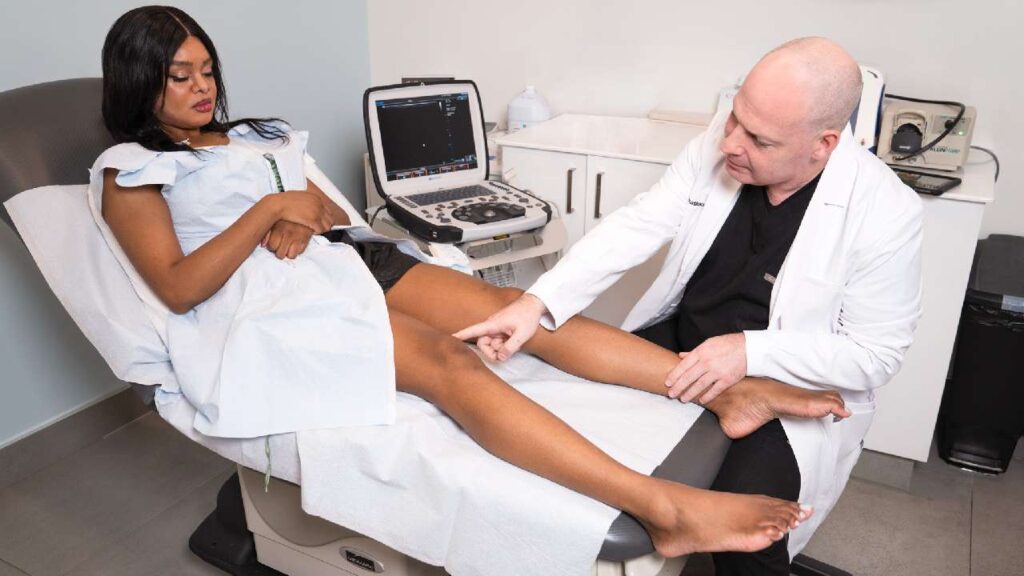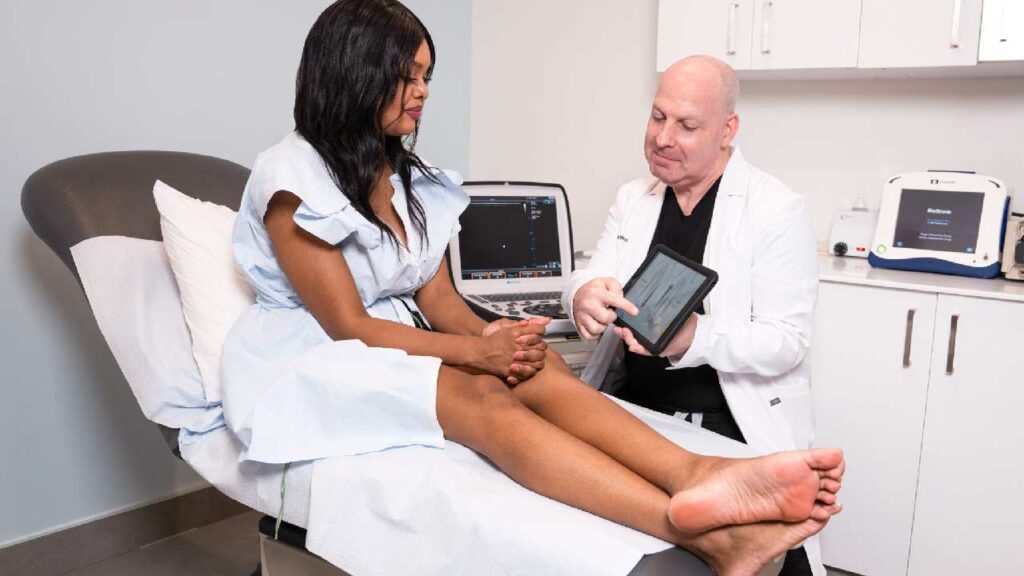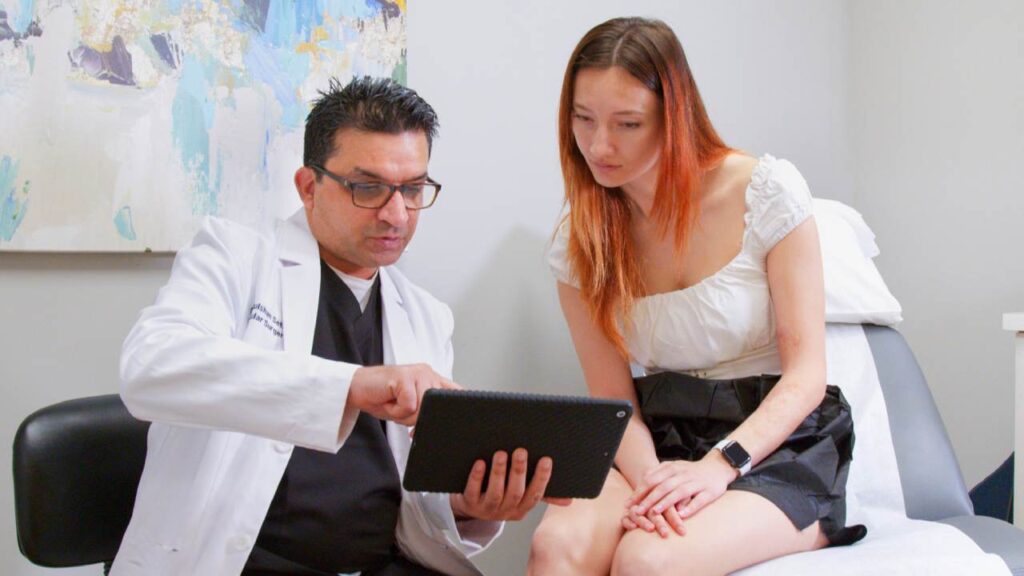Can You Remove Superficial Varicose Veins Without Surgery?
If you have protuberant, painful varicose veins on your legs, you’re probably eager to remove them. But the idea of surgery might be unappealing, particularly if you don’t know what it will entail. The great news is most patients no longer need surgery to remove varicose veins. Newer techniques like radiofrequency ablation, mechanochemical ablation, endovenous laser treatment, vein adhesives, and sclerotherapy have all but replaced traditional phlebectomy for the vast majority of patients.
Those who do need surgery can now consider gentler surgical excision through methods like ambulatory phlebectomy as well. So, the answer to, “Can you have varicose veins removed without surgically extracting them?” is that most people not only can; they should. Click HERE to discuss your options with our Harvard-trained NY vein doctors.

What Are the Different Methods for Excision of a Vein?
There are several ways to conduct excision of a vein. The traditional way was to make multiple incisions through which the doctor accesses the vein and pulls it out of the body, possibly tying it off at a certain point (vein stripping and ligation). This procedure utilizes anesthesia and stitches and potentially requires hospitalization. Patients need time to recover and stay off their feet. It involves common surgical risks and can produce infection, scarring, blood clots, or heavy bleeding. A newer surgery, called ambulatory phlebectomy, uses smaller incisions and local anesthetics, but it still extracts veins from the body, rather than treating it in the body.
The newer, least invasive varicose veins treatments include radiofrequency ablation, endovenous laser treatment, sclerotherapy, mechanochemical ablation, and vein adhesives. These procedures are often referred to by names like ClariVein, VenaSeal, Varithena, or Asclera. These techniques treat the vein within the body, via tiny needles, fibers, or catheters inserted through the skin. With some procedures, doctors will numb the area, but there’s no general anesthesia, hospitalization, or recovery time with these non-surgical techniques. Patients can resume their typical routine after these treatments that take about 15-30 minutes.
What Are the Risks of Various Varicose Veins Treatments?
Surgery poses more risks than removing a vein with minimally invasive tactics. Since surgical vein stripping involves several deep incisions, the risks of bleeding and infection are higher than with non-surgical methods. Additionally, patients can suffer complications from anesthesia, and there’s the potential for tissue or nerve damage during surgery. Some patients deal with long-term pain, scarring, or unsatisfactory results from vein surgery.
With minimally invasive vein removal, the vein disappears within the body, rather than being cut out of the body. It is closed off by treatments that target the vein walls directly, so that it shrinks from sight. As such, infection, bleeding, scarring, and nerve damage are negligible risks. Since there is no usage of general anesthesia, complications from that are eliminated.
Radiofrequency Ablation Varicose Veins Before & After Risks?
Are there any risks at all with procedures like radiofrequency ablation? There are no 100% risk-free medical procedures. But the risks are low, and most are avoidable if you choose the right vein doctor in NY. One key to a low-risk procedure is choosing the right method for you, which is why it’s important to select a board certified vein specialist who studied venous medicine.
Many NY vein treatment clinics are run by other specialists, so they aren’t as knowledgeable about how each procedure works with an individual’s venous pathways. For instance, one possible risk is an allergy to a vein adhesive or tumescent anesthetic. These risks are easily eliminated by vein doctors who know to check for this.
Some patients don’t realize there are risks before treatment, as well. Ignoring varicose veins could lead to venous ulcerations, heavy bleeding, blood clots, or pulmonary embolisms. So, choose a minimally invasive, low-risk treatment with our high-caliber vein doctors and you can proceed with confidence.
Will You Have Pain Years After Varicose Vein Surgery?
One complication patients worry about is having pain years after varicose vein surgery. This includes failure to resolve the pain caused by varicose veins, as well as new pain caused by surgery. This complication is not entirely avoidable with traditional vein surgery, but it is uncommon. However, with non-surgical vein removal, this complication is remarkably rare.
Since minimally invasive vein specialists use Doppler Ultrasound to locate the issue and guide the treatment device, nerve and tissue damage are avoidable. These treatments do not cut the vein or pull it out of the body, and there are no large wounds to heal, so they’re not only painless when performed, they’re also painless afterward. If you have pain from vein surgery at a different vein treatment clinic, contact us to learn how we can help.
What Are the Signs of Blood Clot After Vein Ablation?
Another concern patients have is whether they’ll develop a blood clot after vein ablation. Like pain, blood clots are not completely avoidable with surgery. So, look for sudden throbbing, warmth, redness, or swelling, near the treated area. If you have breathlessness, cough, or chest pain, head to the emergency room to ensure the blood clot hasn’t traveled to your lungs.
With minimally invasive vein treatments, however, there is an extremely low risk of blood clots. We treat the diseased part of the vein by closing off broken valves or varicosities, without slicing through the vein. The risks of heavy bleeding and clots like a deep vein thrombosis are very low with non-surgical procedures.
Since endovenous procedures close off one venous pathway and reroute blood into a different vein, we always look for existing blood clots before deciding which treatment to use. Not all vein clinics in NY have the technology to map your venous anatomy, so choose an accredited vein treatment clinic to prevent complications of undetected blood clots.
Should I Get My Varicose Veins Treated Non-Surgically?
Most patients should treat varicose veins non-surgically. Several options are gentler, faster, safer, and more affordable than surgery for most people. However, some patients should have their veins surgically removed, if the vein is highly tortuous, contains blood clots, or has already been treated surgically elsewhere.
A vein specialist can assess your venous health and medical history and determine the best course of action. If you do require surgery, you might be eligible for gentler options like ambulatory phlebectomy. And if you choose minimally invasive vein specialists, you’ll likely avoid surgery altogether.
Which Leg and Vein Doctor Uses Surgery vs Gentle Methods?
If you’re looking for a doctor to remove veins without surgery, here are the distinctions. A phlebologist is a doctor who studied vein diseases and vein medicine, but not necessarily surgery. A vascular surgeon studied surgical techniques for all blood vessels, and can perform vein surgery, but largely focuses on surgery for blood vessels like arteries.
A vein specialist is an unregulated title that includes dermatologists, phlebologists, estheticians, and others whose training ranges from surface laser treatments to endovenous varicose veins treatments, so choose your vein specialist carefully. The best choice is a phlebologist or vein specialist who studied vein medicine, so don’t hesitate to ask what their title means.
What’s the Best Vein Clinic in NY for Non-Surgical Removal?
If you hope for non-surgical removal of varicose veins, choose a minimally invasive vein clinic staffed by board certified vein specialists who studied vein medicine. These doctors are trained in the latest techniques and avoid unnecessary, outdated surgical methods. Visit our award-winning NY vein specialists at any of our convenient locations for state-of-the-art, non-surgical varicose veins treatment,
What’s the Best Vein Treatment Clinic for Surgical Removal?
If you think you need surgical varicose vein removal, our first tip would be to get a second opinion at our cutting-edge vein clinic in New York. Many vein specialists and vascular surgeons aren’t trained in the latest techniques, so let us assess your condition and see if a non-surgical approach would work better. If you do need surgery, our vein doctors will consider less invasive surgeries like ambulatory phlebectomy that use a small cut or puncture instead of large incisions. We’ll recommend surgery if it’s the best choice for you, but we’ll never recommend it if it’s unnecessary or unsafe for you.
What’s the Best Method for Varicose Veins vs Stretch Marks?
Varicose veins and stretch marks are both unsightly, but they aren’t removed the same way. Stretch marks might shrink with creams, laser treatment, or the passage of time. Varicose vein symptoms might lessen if you wear compression stockings, elevate your legs, or avoid a sedentary lifestyle. But, vein treatments are the only way to truly eliminate varicose veins. Stretch marks are not a health concern like varicose veins can be. If you develop stretch marks, it’s safe to wait and see if they shrink over time, whereas varicose veins warrant a medical consultation soon to prevent complications.
What’s the Best Clinic for Varicose Veins and Spider Veins?
Many patients have both varicose veins and spider veins, so you might be wondering where you can have both removed. Both types of vein damage often stem from the same disease- Chronic Venous Insufficiency, and both can multiply and worsen if you don’t treat that disease. So, choose our comprehensive vein clinic that treats varicose veins, spider veins, and Chronic Venous Insufficiency without surgery, rather than a cosmetic vein clinic that only treats surface damage.





